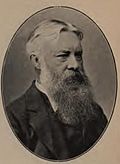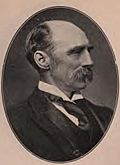For the present constituency, see Hackney South and Shoreditch (UK Parliament constituency).
Quick facts for kids {{{Name}}}
[[{{{Type}}} constituency]] |
[[Image:{{{Map1}}}Constituency.svg|120px|]]
[[Image:England{{{Map2}}}.svg|120px|]] |
| {{{Name}}} shown within [[{{{Entity}}}]], and {{{Entity}}} shown within England |
| Created: |
{{{Year}}} |
| MP: |
{{{MP}}} |
| Party: |
{{{Party}}} |
| Type: |
House of Commons |
| County: |
[[{{{County}}}]] |
| EP constituency: |
[[{{{EP}}} (European Parliament constituency)|{{{EP}}}]] |
Hackney South was a parliamentary constituency in "The Metropolis" (later the County of London). It was represented by nine Members of Parliament to the House of Commons of the Parliament of the United Kingdom, only two of whom, Horatio Bottomley and Herbert Morrison, were elected more than once.
History
The constituency was created under the Redistribution of Seats Act, 1885 when the two-member Parliamentary Borough of Hackney was split into three single-member divisions. The seat, officially the Southern Division of the Parliamentary Borough of Hackney was first contested at the 1885 general election. The constituency was abolished in 1955.
Boundaries
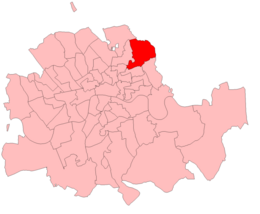
Hackney South in London 1885–1918

Hackney South in London 1918–1950
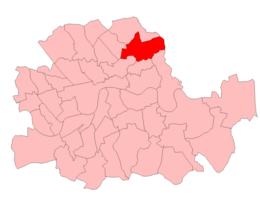
Hackney South in London 1950–1955
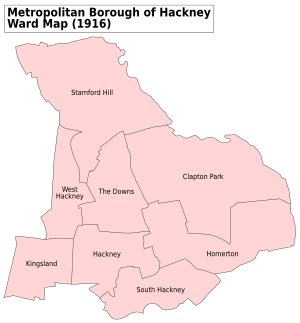
A map showing the wards of Hackney Metropolitan Borough as they appeared in 1916.
1885–1918
In 1885 the constituency was defined as consisting of:
- No. 7 or South Hackney Ward of Hackney Parish
- No. 6 or Homerton Ward of Hackney Parish
- The part of the No. 5 or Hackney Ward of Hackney Parish south of the centres of Everning Road, Upper Clapton Road, and the Upper and Lower Clapton Roads.
1918–1950
The Representation of the People Act 1918 redrew constituencies throughout Great Britain and Ireland. Seats in the County of London were redefined in terms of wards of the Metropolitan Boroughs that had been created in 1900. The Metropolitan Borough of Hackney was divided into three divisions, with the same names as the constituencies created in 1885. Hackney South was defined as consisting of:
- Homerton Ward
- South Hackney Ward
- The part of Clapton Park Ward to the south of a line drawn along the centres of Glenarm Road, Glyn Road and Redwald Road to its junction with Maclaren Street, thence across the recreation grounds in Daubeney Road to the borough boundary at a point fifty feet north of a boundary post situate at the junction of the Waterworks River with the River Lea at Lead Mill Point.
1950–1955
Under the Representation of the People Act 1948 the Boroughs of Hackney and Stoke Newington jointly formed two seats, the borough constituencies of Stoke Newington and Hackney North and Hackney South. Hackney South was enlarged: consisting of the Metropolitan Borough of Hackney except the five wards of Leaside, Maury, Southwold, Springfield and Stamford.
Redistribution
Following a review of constituencies by the Boundary Commission appointed under the House of Commons (Redistribution of Seats) Act 1949, parliamentary seats in the metropolitan boroughs of Bethnal Green, Hackney and Stoke Newington were redrawn. The Hackney South constituency was abolished, with most passing to a new Hackney Central borough constituency, and some parts to Bethnal Green.
Members of Parliament
Elections
Elections in the 1880s
Russell was appointed Attorney General for England and Wales, requiring a by-election.
| 1886 Hackney South by-election |
| Party |
Candidate |
Votes |
% |
±% |
|
Liberal |
Charles Russell |
3,174 |
61.4 |
+3.7 |
|
Conservative |
Andrew Scoble |
1,979 |
38.3 |
−4.0 |
|
Independent Liberal |
Henry Munster |
17 |
0.3 |
New |
| Majority |
1,195 |
23.1 |
+7.7 |
| Turnout |
5,170 |
59.5 |
−11.3 |
| Registered electors |
8,684 |
|
|
|
Liberal hold |
Swing |
+3.8 |
|
Elections in the 1890s
Russell is appointed Attorney General for England and Wales, requiring a by-election.
| By-election, 1892: Hackney South |
| Party |
Candidate |
Votes |
% |
±% |
|
Liberal |
Charles Russell |
Unopposed |
|
Liberal hold |
Russell is appointed Lord of Appeal in Ordinary, becoming Lord Russell of Killowen, causing a by-election.
Elections in the 1900s
Elections in the 1910s
- Roberts was nominated by a breakaway local Liberal Association opposed to Bottomley, which was recognised by the London Liberal Federation.
| 1912 Hackney South by-election |
| Party |
Candidate |
Votes |
% |
±% |
|
Liberal |
Hector Morison |
5,339 |
52.5 |
+3.1 |
|
Conservative |
John Constant Gibson |
4,836 |
47.5 |
+15.9 |
| Majority |
503 |
5.0 |
−12.8 |
| Turnout |
10,175 |
70.1 |
−2.5 |
|
Liberal hold |
Swing |
−6.4 |
|
Elections in the 1920s
| 1922 Hackney South by-election |
| Party |
Candidate |
Votes |
% |
±% |
|
Coalition Unionist |
Clifford Erskine-Bolst |
9,118 |
50.2 |
New |
|
Labour |
Holford Knight |
9,046 |
49.8 |
New |
| Majority |
72 |
0.4 |
N/A |
| Turnout |
18,164 |
56.3 |
+0.9 |
| Registered electors |
32,262 |
|
|
|
Unionist gain from Independent |
Swing |
N/A |
|
Elections in the 1930s
General Election 1939–40
Another General Election was required to take place before the end of 1940. The political parties had been making preparations for an election to take place and by the Autumn of 1939, the following candidates had been selected;
Elections in the 1940s
| General election 1945: Hackney South |
| Party |
Candidate |
Votes |
% |
±% |
|
Labour |
Herbert Butler |
10,432 |
51.6 |
−7.7 |
|
National Liberal |
Stanley Price |
4,901 |
24.2 |
−16.5 |
|
Communist |
William Rust |
4,891 |
24.2 |
New |
| Majority |
5,531 |
27.4 |
+8.8 |
| Turnout |
20,224 |
|
|
|
Labour hold |
Swing |
|
|
Elections in the 1950s
| General election 1950: Hackney South |
| Party |
Candidate |
Votes |
% |
±% |
|
Labour |
Herbert Butler |
35,821 |
61.0 |
+9.4 |
|
Conservative |
Herbert P. Brooks |
15,105 |
25.7 |
+1.5 |
|
Liberal |
Frank Albert Marlow |
5,575 |
9.5 |
New |
|
Communist |
John Richard Betteridge |
1,891 |
3.8 |
−20.4 |
| Majority |
20,716 |
35.3 |
+7.9 |
| Turnout |
61,392 |
77.4 |
|
|
Labour hold |
Swing |
|
|
| General election 1951: Hackney South |
| Party |
Candidate |
Votes |
% |
±% |
|
Labour |
Herbert Butler |
39,271 |
66.5 |
+5.5 |
|
Conservative |
Peter Rawlinson |
18,003 |
30.5 |
+4.8 |
|
Communist |
John Richard Betteridge |
1,744 |
3.0 |
−0.8 |
| Majority |
21,268 |
36.0 |
+0.7 |
| Turnout |
59,018 |
77.1 |
−0.3 |
|
Labour hold |
Swing |
|
|
Sources
- Leigh Rayment's Historical List of MPs – Constituencies beginning with "H" (part 1)






